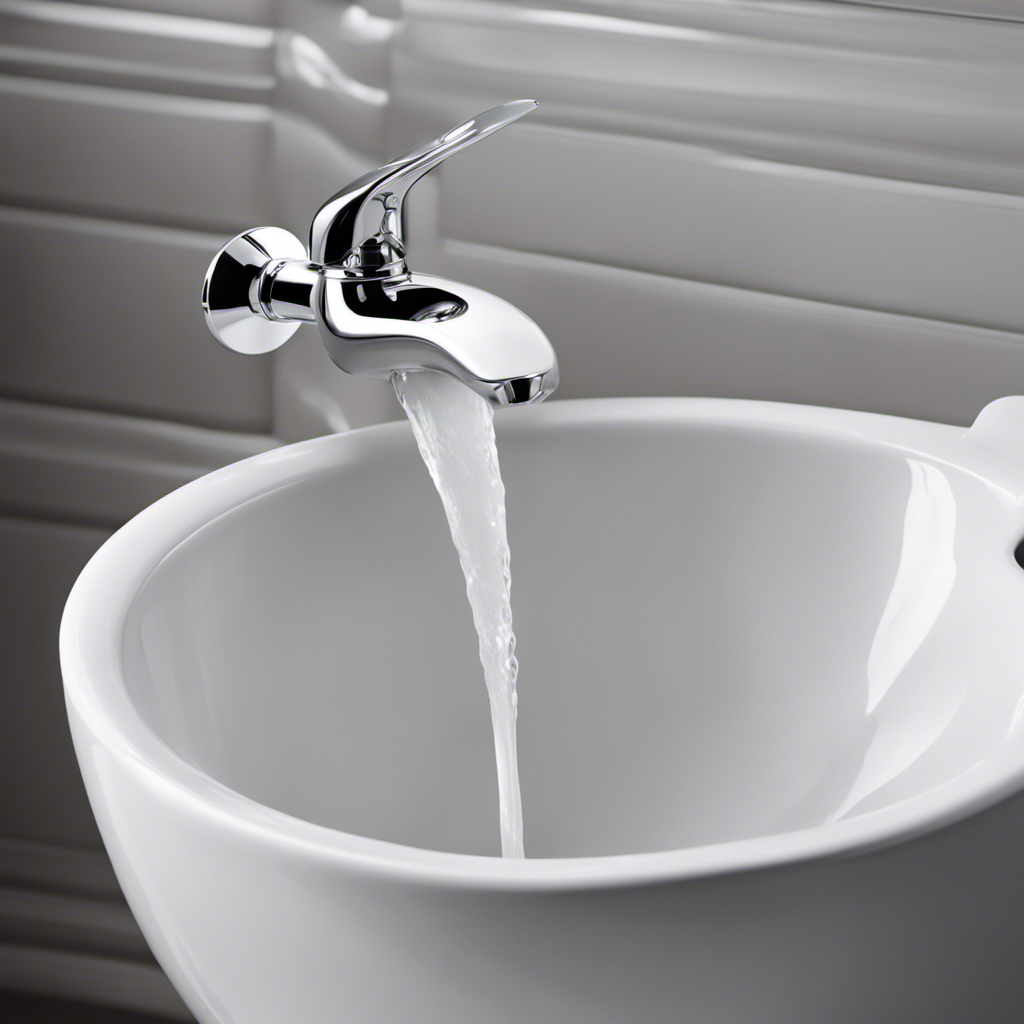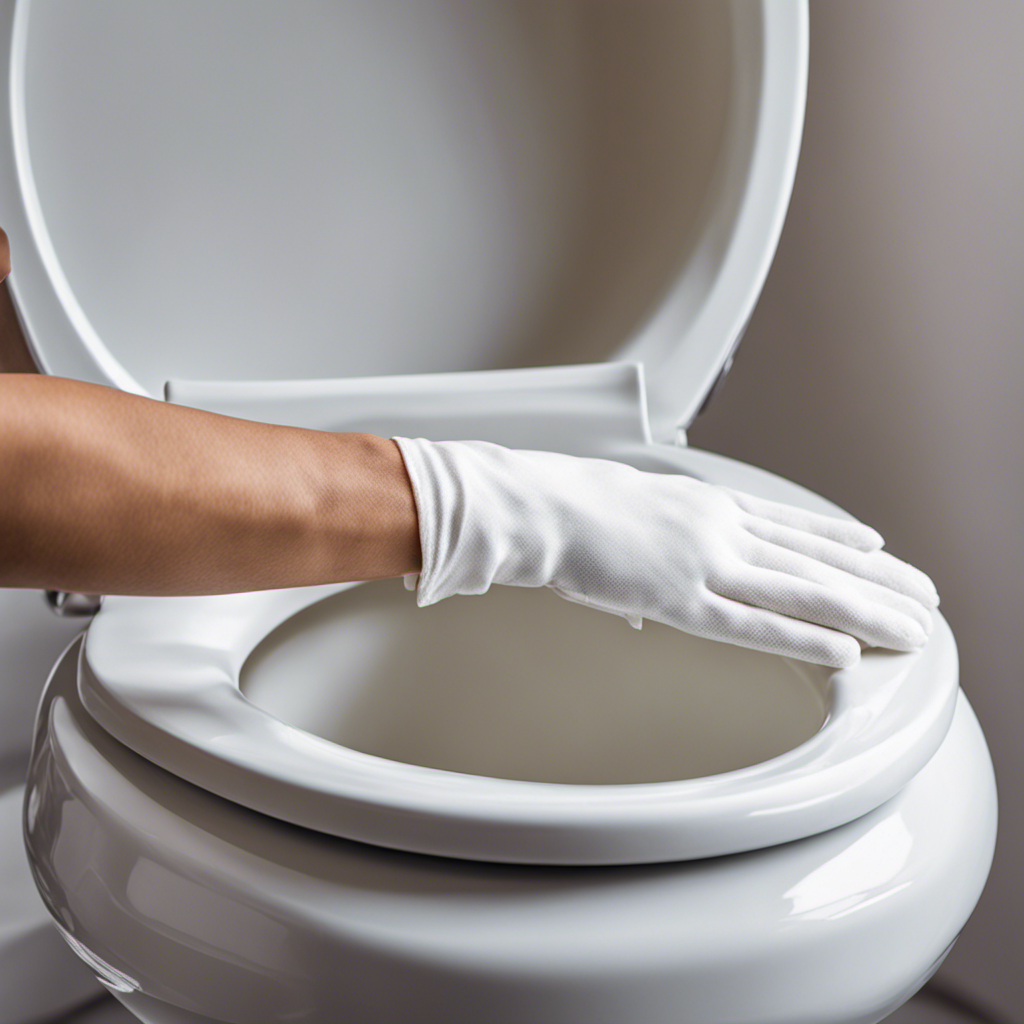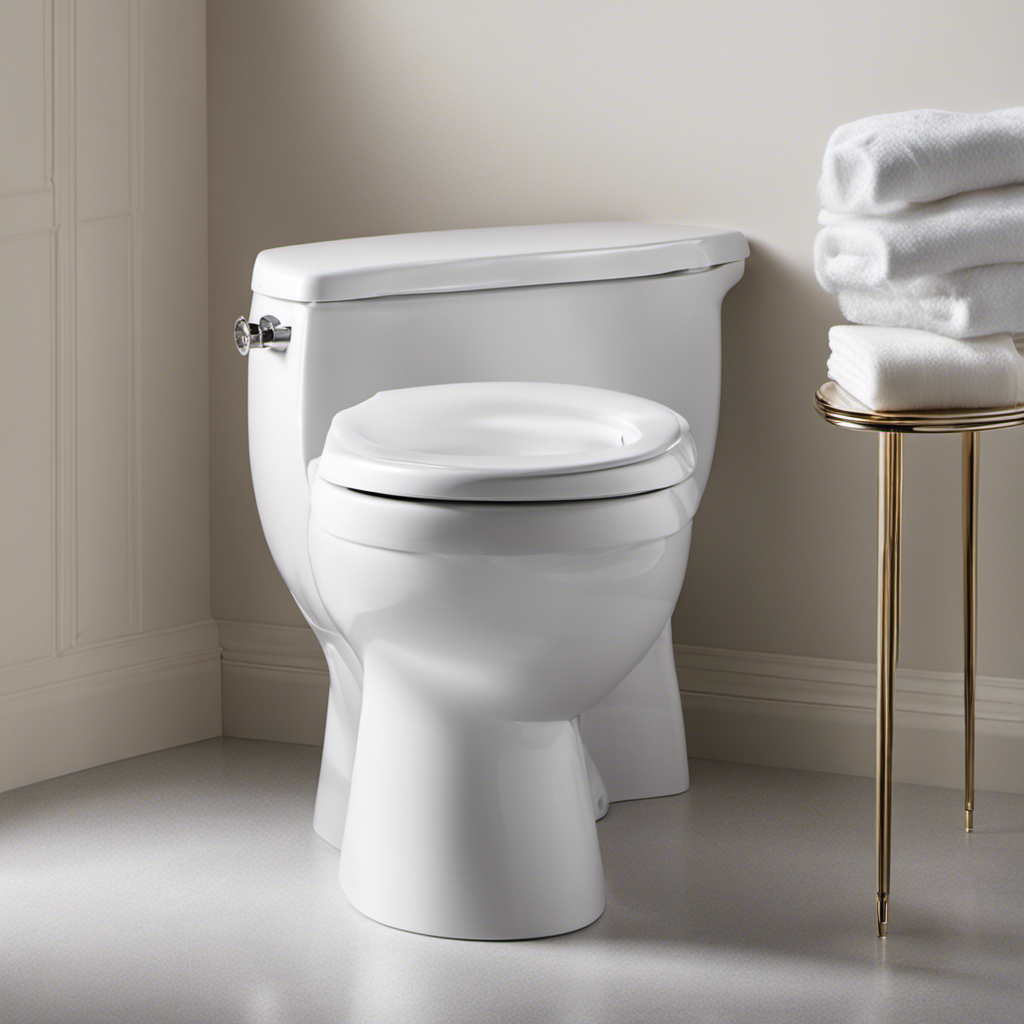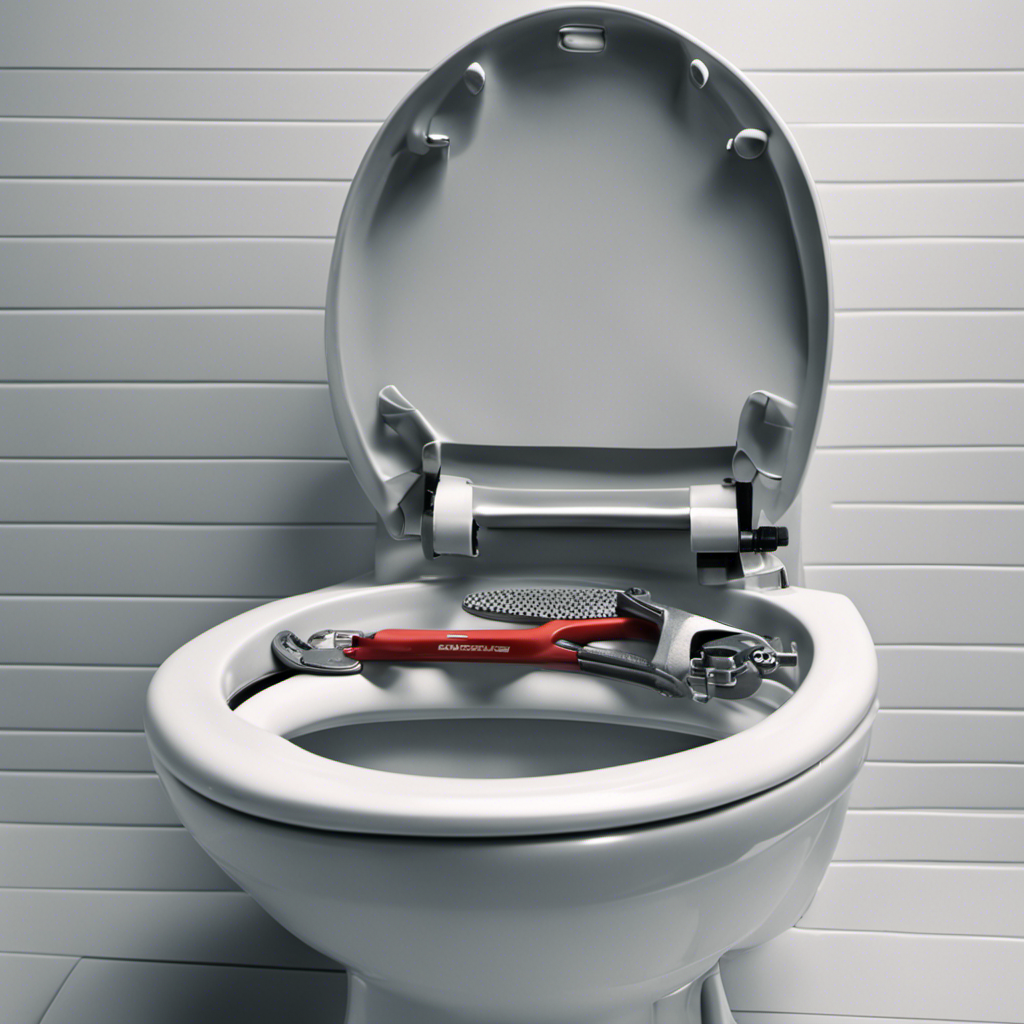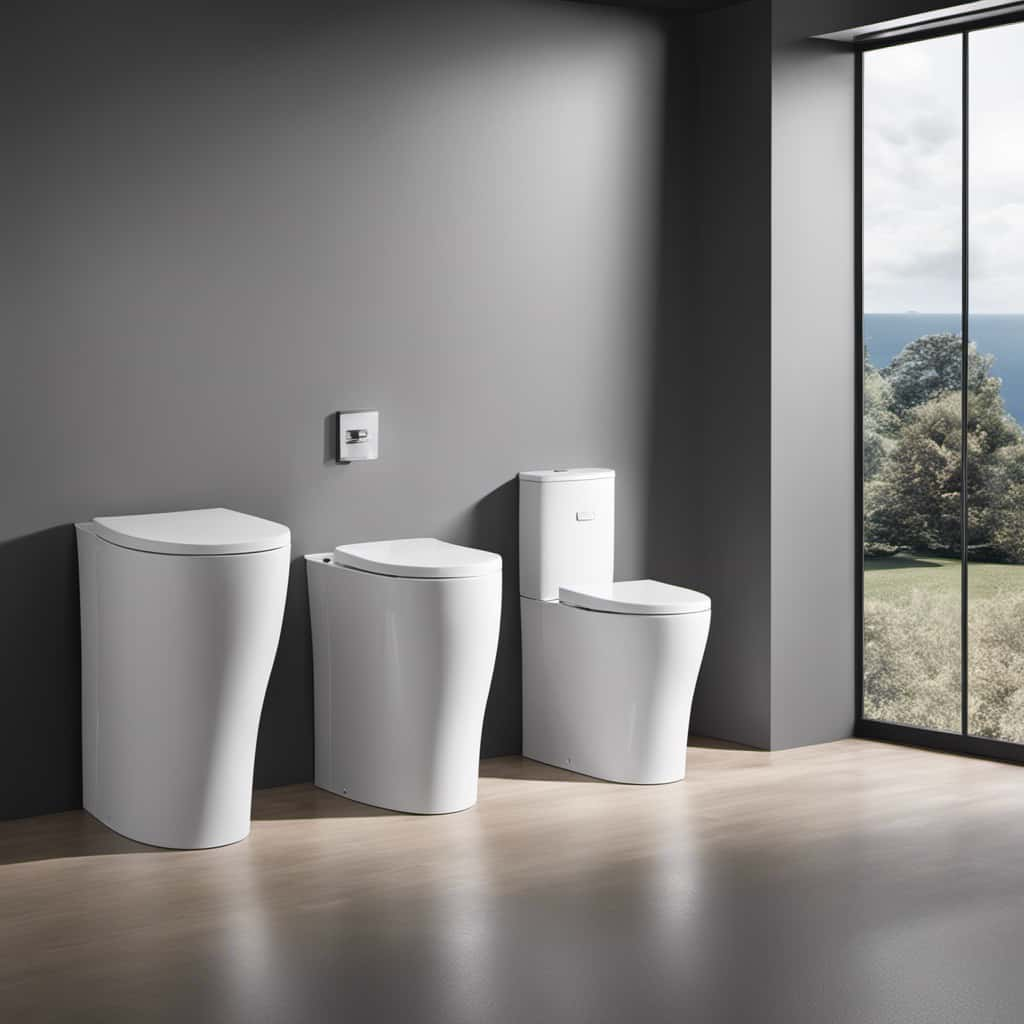As a seasoned handyman, I’ve encountered my fair share of stubborn toilets that simply refuse to flush properly. It’s like trying to push a boulder up a hill, an uphill battle that leaves you frustrated and defeated.
But fear not, for I am here to share my expertise on how to force flush a toilet. In this guide, I will walk you through the ins and outs of the flush mechanism, provide troubleshooting tips, and equip you with the necessary tools to tackle even the most persistent flush problems.
Get ready to conquer those clogs and restore the flow of your porcelain throne.
Key Takeaways
- The flush mechanism consists of several components inside the toilet tank.
- Weak flush pressure can be caused by a clogged drain or insufficient water supply.
- Clogged toilet drains can be unclogged using techniques like plunging, hot water and dish soap, baking soda and vinegar, or a toilet auger.
- A faulty flushing mechanism can disrupt the entire flushing process, but can be fixed by replacing faulty parts or installing a dual-flush system.
Understanding the Flush Mechanism
To understand how to force flush a toilet, you need to know how the flush mechanism works.
The flush mechanism of a toilet consists of several components inside the toilet tank that work together to create a powerful flush. One key component is the water pressure.
When you press the flush handle, it lifts a flapper valve at the bottom of the tank, allowing water to rush into the bowl. The water pressure builds up as it fills the tank, creating a force that pushes the waste down the drain.
This forceful flow of water effectively flushes away the waste, leaving the bowl clean and ready for the next use. Understanding the role of water pressure in the flush mechanism is crucial for successfully forcing a flush if necessary.
Identifying Common Flush Issues
As an expert in toilet mechanics, I’ve encountered three common flush issues that homeowners often face.
The first issue is weak flush pressure. This occurs when there isn’t enough force to effectively remove waste from the bowl, leading to unsatisfactory results.
The second issue is clogged toilet drains. This can cause water to back up and prevent proper flushing, resulting in a messy and inconvenient situation.
Lastly, a faulty flushing mechanism can disrupt the entire flushing process. This makes it difficult or even impossible to flush the toilet properly.
Weak Flush Pressure
The weak flush pressure in your toilet can be caused by a clogged pipe. When the drain is clogged, water cannot flow freely from the toilet tank to the bowl, resulting in a weak flush. To understand how a clogged drain affects the flush pressure, let’s take a look at the components involved:
| Component | Function | Potential Issues |
|---|---|---|
| Clogged Drain | Blocks water flow | Low flush pressure |
| Toilet Tank | Holds water for flushing | Insufficient water supply |
When the drain is clogged, water cannot pass through smoothly, reducing the force of the flush. Additionally, if the toilet tank does not have enough water, it can also contribute to weak flush pressure. To address this issue, it is important to identify and clear any clogs in the drain. Once the clogged drain is resolved, the flush pressure should improve. Now, let’s move on to the next section about a clogged toilet drain.
Clogged Toilet Drain
When the drain is clogged, it can lead to reduced water flow and a weaker flush. As a homeowner, it can be frustrating to deal with a clogged toilet. Luckily, there are remedies and techniques that can help unclog the drain and restore proper function to your toilet.
Here are four effective methods to consider:
-
Plunger Technique: Use a toilet plunger to create suction and dislodge the clog. Make sure to create a tight seal around the drain and push and pull vigorously.
-
Hot Water and Dish Soap: Pour a generous amount of hot water mixed with dish soap into the toilet bowl. Let it sit for a few minutes before attempting to flush.
-
Baking Soda and Vinegar: Combine half a cup of baking soda with half a cup of vinegar. Pour this mixture into the toilet bowl and let it sit for about half an hour. Flush the toilet to see if the clog has cleared.
-
Toilet Auger: If the clog persists, consider using a toilet auger. Insert the auger into the drain and rotate it to break up the blockage.
Faulty Flushing Mechanism
| To fix a faulty flushing mechanism, you can start by checking the water level in the tank. A common issue that can cause a weak flush is if the water level is too low. Ideally, the water level should be about an inch below the overflow tube. If it’s lower than that, you can adjust the float valve or fill valve to increase the water level. Another possible cause of a faulty flush is a leak in the tank or the flapper. These leaks can waste a significant amount of water and can be fixed by replacing the faulty parts. Additionally, if you’re looking for a more water-saving flush option, you can consider installing a dual-flush system that allows you to choose between a full or partial flush depending on your needs. | Common Issues | Troubleshooting |
|---|---|---|
| Low water level | Adjust float valve or fill valve | |
| Tank or flapper leaks | Replace faulty parts | |
| Water-saving flush option | Install dual-flush system |
To gather the necessary tools for the job, you will need a few basic items.
Gathering the Necessary Tools
First, you’ll need a plunger to force flush the toilet. Here are the necessary tools to gather:
-
Toilet plunger: This essential tool creates pressure to dislodge clogs by creating a vacuum effect.
-
Drain snake: If the plunger doesn’t do the trick, a drain snake can be used to manually remove stubborn blockages.
-
Rubber gloves: Protect your hands from germs and potential mess while handling the tools.
-
Bucket: Having a bucket nearby is useful for collecting water or any debris that may come out during the process.
With these tools on hand, you’ll be well-prepared to tackle any toilet flushing issues.
Now, let’s move on to the step-by-step guide to force flush the toilet and restore normal functionality.
Step-by-Step Guide to Force Flush
Now that we have gathered all the necessary tools, let’s move on to the step-by-step guide to force flush a toilet.
It is important to note that this method should only be used as a temporary solution and should not replace proper toilet maintenance or repair.
To begin, locate the water supply valve behind the toilet and turn it off. This will prevent any additional water from entering the tank.
Next, remove the lid from the toilet tank and carefully lift the flapper valve. This will release the water from the tank into the bowl.
If the toilet doesn’t flush properly, you can use a plunger to create pressure and force the water down the drain. Make sure to plunge vigorously and create a tight seal around the drain.
Troubleshooting Tips for Persistent Flush Problems
Having trouble with weak flushes, clogged pipes, or a malfunctioning toilet handle? Fear not, as I’m here to provide you with expert advice on these common issues.
In this discussion, we will explore effective solutions for weak flushes, including adjusting the water level or replacing the flapper valve.
We will also delve into clogged pipe remedies, such as using a plunger or a drain snake.
Lastly, we will discuss the necessary adjustments to fix a faulty toilet handle.
Weak Flush Solutions
To fix a weak flush, you can try adjusting the water level in the tank. Here are some steps you can take to increase the flushing power of your toilet:
-
Check the water level: Ensure that the water level in the tank is at the designated mark. If it is too low, adjust the float valve to increase the water level.
-
Clean the rim jets: Over time, mineral deposits can build up in the rim jets, reducing water flow and causing a weak flush. Use a small brush to clean these jets and restore their efficiency.
-
Inspect the flapper: The flapper is responsible for releasing water into the bowl during a flush. If it is worn out or not sealing properly, it can lead to a weak flush. Replace the flapper if necessary.
-
Increase water pressure: If all else fails, you can try increasing the water pressure in your home. This can be done by adjusting the pressure regulator or contacting a plumber to assess and fix any issues.
Clogged Pipe Remedies
If you’re experiencing a clogged pipe, you can try using a plunger to clear the blockage. However, if you don’t have a plunger or if it doesn’t work, there are alternative methods you can try.
One option is to use a drain snake, which is a long, flexible tool that can reach deep into the pipe to break up the blockage.
Another option is to use a mixture of baking soda and vinegar as a natural drain cleaner. Simply pour half a cup of baking soda down the drain, followed by half a cup of vinegar. Let it sit for about 30 minutes, then flush it with hot water. This combination creates a chemical reaction that can help break down the clog.
Toilet Handle Adjustments
To adjust your toilet handle, simply locate the adjustment screw on the back of the handle and use a screwdriver to tighten or loosen it as needed. This simple process can help ensure that your toilet flushes properly.
Here are four important things to know about toilet handle adjustments:
- Adjusting the handle can fix common issues like a loose or sticking handle.
- Tightening the adjustment screw can prevent the handle from jiggling or falling off.
- Loosening the screw can make the handle easier to push down for a flush.
- If the handle is broken or damaged beyond repair, consider a toilet handle replacement for optimal performance.
By properly adjusting your toilet handle, you can maintain the correct water level in the tank and ensure a smooth flush.
Now, let’s explore some maintenance and prevention techniques to keep your toilet in top shape.
Maintenance and Prevention Techniques
Regular maintenance can help prevent clogs and ensure proper flushing of a toilet. One important aspect of toilet maintenance is monitoring the water level in the toilet tank.
The water level in the tank should be set at the appropriate height to ensure optimal flushing performance. To adjust the water level, locate the fill valve in the toilet tank and turn the adjustment screw clockwise to raise the water level or counterclockwise to lower it.
It is crucial to find the right balance, as a water level that is too high can cause constant running and a water level that is too low may result in weak flushes. By regularly checking and adjusting the water level, you can maintain a properly functioning toilet and avoid potential flushing issues.
Frequently Asked Questions
Can the Force Flush Method Be Used for All Types of Toilets?
Force flush can be effective on most toilets, but it’s important to understand the science behind it. By increasing water pressure, force flush helps clear clogs. However, plunging is generally more effective for stubborn blockages.
How Often Should I Force Flush My Toilet?
Force flushing my toilet regularly is essential for maintaining its functionality. It helps prevent clogs and keeps the plumbing system running smoothly. Signs like slow drainage or water backup indicate the need for a force flush.
Can Force Flushing Cause Any Damage to the Toilet?
Force flushing a toilet can potentially cause damage if not done correctly. It’s important to avoid common mistakes such as using excessive force or using improper tools. Proper technique and regular maintenance can help prevent any harm to the toilet.
Are There Any Alternative Methods to Force Flush a Toilet?
There are alternative methods to force flush a toilet, such as using plunger alternatives or natural DIY toilet flush solutions. These options can be effective and environmentally friendly.
What Should I Do if Force Flushing Doesn’t Resolve the Issue?
If force flushing doesn’t work, try using plunger alternatives like a toilet auger or a drain snake. If all else fails, it’s best to seek professional plumbing assistance to resolve the issue.
Conclusion
In conclusion, knowing how to force flush a toilet can save you from the frustration of a clogged or weak flushing toilet. By understanding the flush mechanism and identifying common issues, you can effectively troubleshoot and resolve the problem.
Armed with the necessary tools and following the step-by-step guide provided, you can easily restore the proper flushing function to your toilet. For example, imagine you have guests over for a dinner party and the toilet gets clogged. By knowing how to force flush, you can quickly fix the issue and avoid any embarrassing moments.
Remember to regularly maintain and prevent future flush problems with the techniques outlined in this article.
